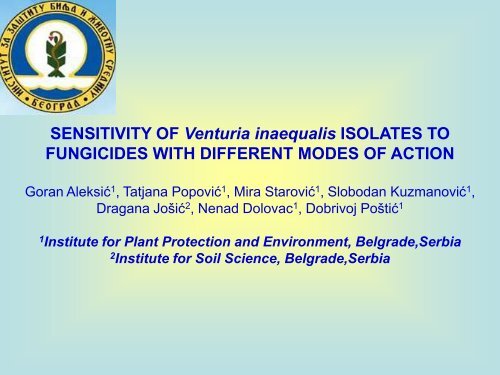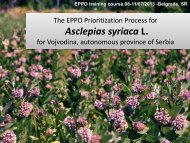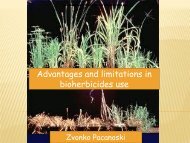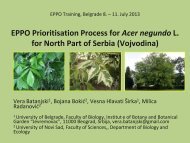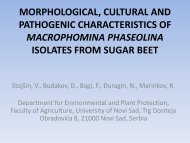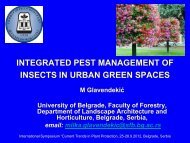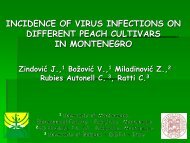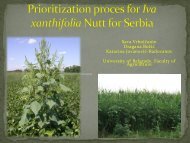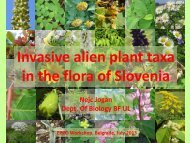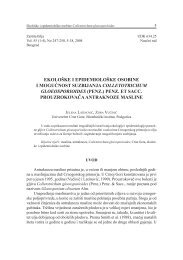SENSITIVITY OF Venturia inaequalis ISOLATES TO ... - Izbis
SENSITIVITY OF Venturia inaequalis ISOLATES TO ... - Izbis
SENSITIVITY OF Venturia inaequalis ISOLATES TO ... - Izbis
You also want an ePaper? Increase the reach of your titles
YUMPU automatically turns print PDFs into web optimized ePapers that Google loves.
<strong>SENSITIVITY</strong> <strong>OF</strong> <strong>Venturia</strong> <strong>inaequalis</strong> <strong>ISOLATES</strong> <strong>TO</strong><br />
FUNGICIDES WITH DIFFERENT MODES <strong>OF</strong> ACTION<br />
Goran Aleksić 1 , Tatjana Popović 1 , Mira Starović 1 , Slobodan Kuzmanović 1 ,<br />
Dragana Jošić 2 , Nenad Dolovac 1 , Dobrivoj Poštić 1<br />
1<br />
Institute for Plant Protection and Environment, Belgrade,Serbia<br />
2<br />
Institute for Soil Science, Belgrade,Serbia
Apple scab caused by <strong>Venturia</strong> <strong>inaequalis</strong> (Cooke)<br />
Winter (anamorph Spilocaea pomi Fr.) is the most<br />
important apple disease in the world. Chemical<br />
control with fungicides has been the main measure of<br />
disease control. During the growing season, in order<br />
to keep the trees scab free, more than 20 treatments<br />
may be needed. In order to protect apple trees from<br />
the apple scab, a wide spectrum of different chemical<br />
preparations is used from different chemical groups,<br />
with different mode of action (preventative,<br />
preventative-curative, curative and eradicative) which<br />
are often combined in order to enhance their<br />
effectiveness or avoid development of resistance.
Unfortunately, fungicide resistance has been<br />
observed in some orchards. Investigating<br />
occurrence of reduced sensitivity of pathogens to<br />
fungicides is of great importance in conditions of<br />
intensive crop protection.
Fungicide resistance in V. <strong>inaequalis</strong> is well<br />
documented worldwide for old fungicides such<br />
as dodine (Köller and Wilcox, 1999; Broniarek-<br />
Niemiec and Bielenin, 2008), benzimidazole<br />
(Koenraadt et al., 1992), demethylation inhibitors<br />
(DMIs) (Sholberg and Haag, 1993; Köller et al.,<br />
1997), and newer fungicides such as strobilurins<br />
(Olaya and Koller, 1999; Fontaine et al., 2009) and<br />
anilinopyrimidines (Küng et al., 1999). There are<br />
no reports in the literature about the sensitivity to<br />
mancozeb, an old fungicide still used for apple<br />
scab control, either used alone or mixed mainly<br />
with DMIs as an anti-resistance strategy.
The objective of this research was to determine<br />
the sensitivity of V.<strong>inaequalis</strong> populations<br />
isolated from treated and untreated apple<br />
orchards to the difenoconazole, flusilazole,<br />
cyprodinil, pyrimethanil, kresoxim-methyl,<br />
captan and mancozeb fungicides.
MATERIAL AND METHODS<br />
The purpose of this trial is to test, in vitro, the<br />
effectiveness of some fungicides on the mycelia<br />
growth of <strong>Venturia</strong> <strong>inaequalis</strong> isolated from<br />
infected apple leaves collected from treated<br />
(isolate Morovic – M and M1) and untreated<br />
(isolate Nestin – N and N1) orchards during 2011.<br />
Isolations were carried out according to the<br />
method of Borić (1987) and Aleksić (1996).<br />
Isolates were grown for six weeks on PDA at<br />
20°C.
Commercial formulations of seven fungicides,<br />
representing different chemical families, were<br />
used in this study. The experiment was done<br />
using a method described by Popović (2004).<br />
Appropriate volumes of each fungicide were<br />
added to the PDA at approximately 50°C in the<br />
quantities needed to achieve the final<br />
concentrations at the rate of the registered dose<br />
and poured in sterilized 50 mm Petri plates.
Active<br />
ingredient<br />
TABLE 1. Fungicides on tested fungal cultures<br />
of <strong>Venturia</strong> <strong>inaequalis</strong><br />
Fungicide<br />
Tested<br />
concentrations<br />
Tested<br />
doses / litar<br />
Difenoconazole Score 250 EC 0.02 1 (0.005) 2 0.2 mL<br />
Flusilazole Punch 40 EC 0.01 1 (0.004) 2 0.1 mL<br />
Cyprodinil Chorus 75 WG 0.025 1 (0.01875) 2 0.25 g<br />
Pyrimethanil Pyrus 400 SC 0.15 1 (0.06) 2 1.5 mL<br />
Kresoximmethyl<br />
Stroby DF 0.02 1 (0.01) 2 0.2 g<br />
Captan Merpan 80 0.2 1 (0.16) 2 2.0 g<br />
Mancozeb Mankogal 0.25 1 (0.2) 2 2.5 g<br />
1<br />
% of fungicide<br />
2<br />
% of active ingredient
Mycelia plug (1 mm in diameter), obtained from the<br />
actively growing cultures, were transferred to<br />
fungicide amended plates. The Control was PDA<br />
plates without the addition of the fungicide. There<br />
were four replicates for each fungicide. The dishes<br />
were incubated at 20°C in the dark and the diameter<br />
of each colony was measured twice perpendicularly.
RESULTS<br />
Four isolates (M, M1, N1 and N) of V. <strong>inaequalis</strong>,<br />
originating from two localities on the teritory of Serbia<br />
(Morović and Neštin) were used for investigations in this<br />
work. Isolates from Morović locality were sampled from<br />
commercial apple orchards area of 100 ha, in which<br />
intensive measures for apple scab control are<br />
implementing for many years. This orchard had<br />
applications of the entire range of fungicides registered<br />
for apple scab control. Isolates from locality Neštin were<br />
taken from individual apple trees distant from any<br />
commercial orchards. No fungicides have been applied<br />
for apple scab control, and these isolates could be<br />
considered wild or organic isolates.
TABLE 2. Growth of four <strong>Venturia</strong> <strong>inaequalis</strong> isolates<br />
on PDA medium with tested fungicides<br />
Active<br />
ingredient<br />
Fungicide<br />
Dose/<br />
lit.<br />
Isolate (average growth in mm)<br />
M D.t. M1 D.t. N D.t. N1 D.t.<br />
Difenoconazole Score 250EC 0.2 mL 1.0 a 1.0 a 1.0 a 1.0 a<br />
Flusilazole Punch 40 EC 0.1 mL 1.0 a 1.0 a 1.0 a 1.0 a<br />
Cyprodinil Chorus75WG 0.25 g 1.0 a 1.0 a 1.0 a 1.0 a<br />
Pyrimethanil Pyrus 400SC 1.5 mL 1.0 a 1.0 a 1.0 a 1.0 a<br />
Kresoximmethyl<br />
Stroby DF 0.2 g 1.0 a 12.75 b 1.0 a 1.0 a<br />
Captan Merpan 80 2.0 g 1.0 a 1.0 a 1.0 a 1.0 a<br />
Mancozeb Mankogal 2.5 g 1.0 a 1.0 a 1.0 a 1.0 a<br />
Control - - 19.8 b 20.13 c 21.88 b 29.38 b<br />
LSD 0.05<br />
0.44 0.61 2.82 0.33
Growth in mm<br />
Growth of four <strong>Venturia</strong> <strong>inaequalis</strong> isolates on PDA medium<br />
with tested fungicides<br />
30<br />
25<br />
20<br />
15<br />
10<br />
5<br />
Difenoc.<br />
Flusil.<br />
Cyprod.<br />
Pyrimet.<br />
Kr.-methyl<br />
Captan<br />
Mancozeb<br />
Control<br />
0<br />
M M1 N N1<br />
Isolates
FIGURE 1. Isolate M; K-control, D-difenoconazole, F-flusilazole,<br />
P-pyrimethanil, C-cyprodinil, S-kresoxim-methyl
FIGURE 2. Isolate M; K-control, D-difenoconazole, F-flusilazole,<br />
C-cyprodinil, P-pyrimethanil, S-kresoxim-methyl
DISCUSSION<br />
V. <strong>inaequalis</strong> is the most important disease in apple<br />
production. About 75% of the total application of<br />
pesticides applied in the production of apples are for the<br />
fungal diseases control (of which 70% is used for apple<br />
scab control alone. A major problem in protecting apples<br />
from this pathogen is the fact that a small number of<br />
fungicides are being used in ever increased quantity. This<br />
fact contributes to the occurence of pathogen resistance<br />
or reduced susceptibility of the pathogen towards used<br />
fungicides, due to capacity to the pathogen for genetic<br />
variation (Aleksić et al., 2005). According to Köller (1988)<br />
most fungicides used to control pathogens have a<br />
specific mechanism of action (eg. DMI fungicides), and it<br />
was clear that there is a risk of resistance development.
According to the results of testing the biological efficacy of<br />
some fungicides (QoI and DMI), conducted during two growing<br />
periods, Aleksić (2006) found that the examined products<br />
showed high efficiency in both preventive and curative control<br />
of apple scab. Similar results have been announced Balaz and<br />
Knezevic (2003) examining the efficacy of newer fungicides in<br />
controlling apple scab and apple powdery mildew. In studies<br />
conducted during 1998, 1999 and 2002, the authors found that<br />
the best efficacy in controlling apple scab was demonstrated<br />
by a group of strobilurins (trifloxystrobin and kresoxim-methyl)<br />
They found no statistically significant differences in the<br />
efficiency of the the preparations tested in this group of<br />
compounds. They then tested a group of DMI fungicides -<br />
Difenoconazole (product-Score 250 EC), which exhibited a<br />
lower efficacy in controlling apple scab.<br />
In our in vitro experiments, colony growth of V. <strong>inaequalis</strong> was<br />
registered only in the treatment with kresoxim-methyl, which<br />
leads to the conclusion that there was an appearance of<br />
pathogens resistance to this fungicide.
Recent studies by other authors identified reduced<br />
sensitivity of pathogen to the compounds of the<br />
strobilurin group (Köller et al., 2004) which is consistent<br />
with the results obtained in this paper. According to Kuck<br />
and Mehl (2003), the resistance to strobilurins in the field<br />
is noticed on several pathogens since 1998. Mutations of<br />
the G143A are mostly responsible for the occurence of<br />
this resistance. According to Brunelli et al. (2003), in the<br />
case of fungicides in the strobilurin group, the second<br />
generation fungicides (trifloxystrobin) exhibited greater<br />
efficacy than the previous generation (kresoksim-methyl).
The occurence of resistance in another very important<br />
group of fungicides – DMI, was observed even twenty<br />
years ago. The problems with decreasing effectiveness of<br />
these fungicides can occur after several years of their<br />
intensive use. Among them there is no cross-resistance.<br />
The genetic basis of resistance to the DMI is complex and<br />
has not been sufficiently studied. It is polygenic and<br />
developed through a process of gradual decline in<br />
pathogen sensitivity to fungicides (Gaunt et al., 1996).<br />
According to Pscheidt (2004) resistance to DMI fungicides<br />
in the United States is noticed in several states and in<br />
several cultures. The powdery mildew and apple scab<br />
causal agents are the first pathogens in which the<br />
emergence of resistance observed.


